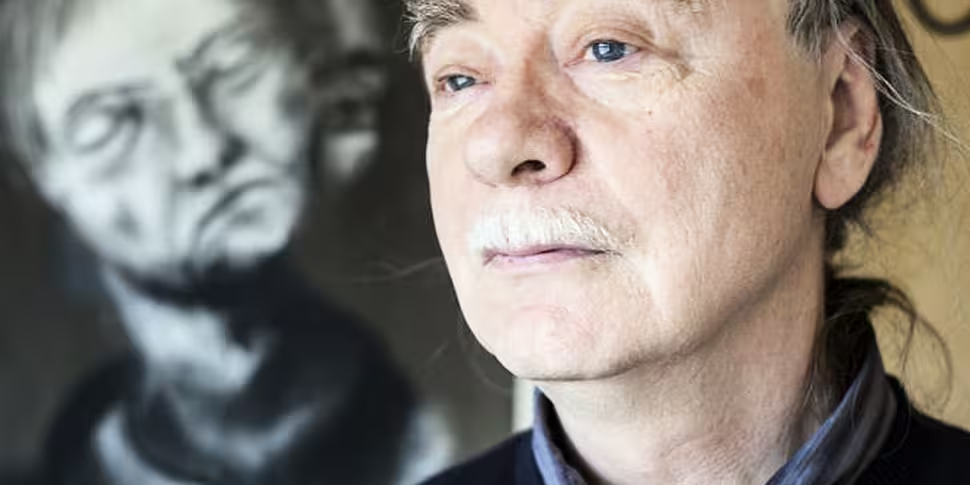Newstalk Magazine is available now for free from the Apple app store.
The paintings of Eddie Cahill are undeniably dark. Yet their author’s demeanour could be described as understated, at times gentle even. The brother of notorious gang boss Martin Cahill aka The General gave a rare broadcast interview to Newstalk’s Orla Barry last month, ahead of his latest exhibition in Dublin.
Now in his early 60s, Cahill says it was either a life of crime or going on the dole which he could not abide. From early childhood, with his 14 siblings in Dublin’s North Inner City, Cahill adopted an ‘us and them’ mentality towards all authority – be it the industrial school he was sent to as a teenager or the prison authorities whom he still views with mild contempt to this day.
It was during Cahill’s second stint in prison that his interest in painting began. In 1990, he was handed down an 8-year sentence – having been previously convicted for robbery – after his drug dealer’s house was raided while Cahill was using drugs on the premises.
Marked as something of a firebrand, Cahill was soon transferred from Mountjoy to Portlaoise prison. One year in, he became aware of an “outside course” in art classes that his fellow inmates had enrolled in. Wary of tokenism in prison education, Cahill was reluctant to attend at first. “If it belonged to the prison I wouldn’t have had anything to do with it,” he admits but as the course was run by the National College of Art and Design, Cahill was intrigued.
It was the quality of the teachers, in particular Brian Maguire, who Cahill viewed as being “not much different from the prisoners themselves” that impressed him most. He would turn up to watch but never picked up a brush. Slowly, he began sneaking materials back to his cell and that’s where he would allow himself to paint in private. It wasn’t long before the four walls in Cahill’s cell were covered in paintings from floor to ceiling. That was 23 years ago.
Insider by Eddie Cahill

By 1995, his first exhibition took place in the Project Arts Centre in Dublin while Cahill was still inside. He wasn’t permitted to attend. The reaction was mixed, as he expected, but Cahill was “just happy that it happened”. The Irish Times art critic Aidan Dunne praised his work and some of his pieces were sold though the monies were “kept on the outside”.
Unbeknownst to him at the time, Cahill’s endeavours into the world of painting were undoubtedly a personal journey. “I needed to give up the way I was so I needed something else and this was perfect,” he reflects.
But he is determined not to return to his old ways. He remembers how former governor of Mountjoy Prison John Lonergan told him it takes people like Cahill, not 21, but 42 years before they are able to mature and “get the keys to the door” which he still believes to be true. He laughs heartily with the realisation that his arthritis would prevent him from “jumping over bank counters these days anyway”.
Cahill is aware that younger criminals may look up to him and his brother as the godfathers of Irish crime. The gang successful carried out 40 armed robberies over 15 years but he would warn anyone off going down the road he went down. “I would always talk against them getting involved in crime. I do feel we were a little bit responsible… but I’d like them to be like this Cahill today.”
Even now there are remnants of a wily troublemaker – perhaps his long ponytail is a nod to his rebellious past – but what is most striking about Cahill is his somewhat jovial nature. He chuckles throughout the interview. He appears to have made peace with his demons though he is not entirely without remorse. “I would feel regret, I wouldn’t feel guilt. It was a dog-eat-dog kind of thing. I didn’t care and they didn’t care. It’s a bit late coming along for apologies. I don’t do apologies.”
The art class at Portlaoise prison has since stopped which Cahill regards suspiciously. “It was a serious class with some of the top class artists in the country… but it wasn’t liked by the prison authorities.” He’s still in contact with his former gang mates who regularly jeer his now mentor Brian Maguire for “destroying a good man”.
The irony of Cahill’s career change is not lost on him. £30 million pounds worth of paintings were stolen by Martin Cahill’s gang from Russborough House in 1986. He gets “a buzz” out of thinking about his current “honest” profession. “I would never feel pain for the artist because if somebody put their liberty at risk for one of my paintings, I would be well pleased,” he laughs. “That’s better than somebody buying them!”
There have been plenty of exhibitions throughout the years and the reaction has been largely positive. Asked what that means to him and there’s a large intake of breath. He recalls an exhibition at Anne Bradley’s gallery in Dundalk when the same question was put to him and he replies: “Before this I would have been sticking you up with a gun and now I’m selling you paintings... it was a bridge into the ‘us and them’ world for me. I started thinking they weren’t as different as I thought they were.”
Listen to the full interview with Eddie Cahill below.
A small number of works may still available from the Origin Gallery, 37 Fitzwilliam Square, Dublin 2, facebook.com/theorigingallery. Mark McLoughlin's documentary, Outsider, will be shown on RTE in late April.
This article originally appeared in Newstalk Magazine for iPad in March, for more details go here.









